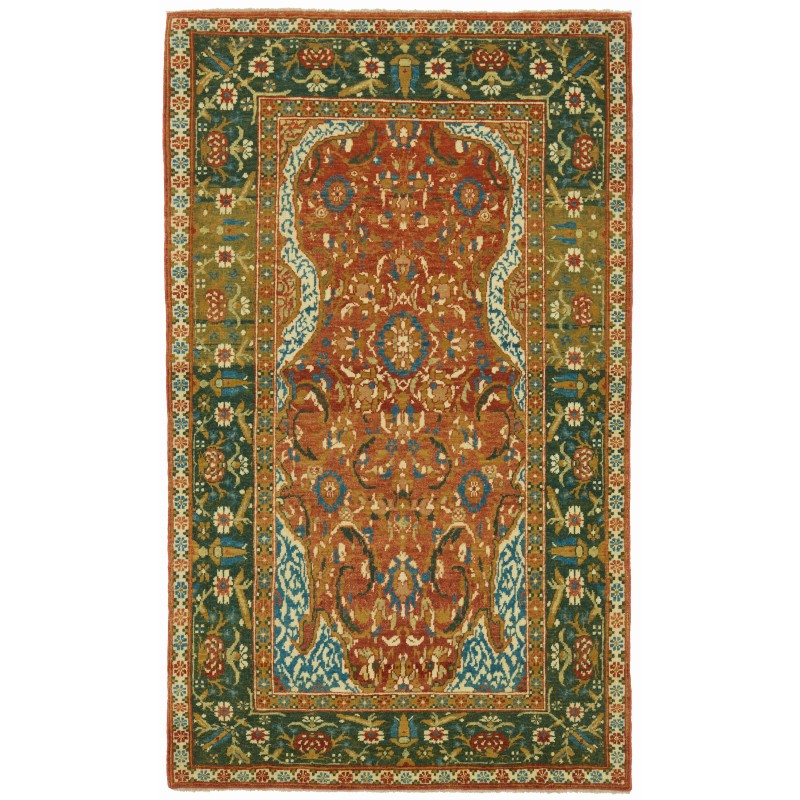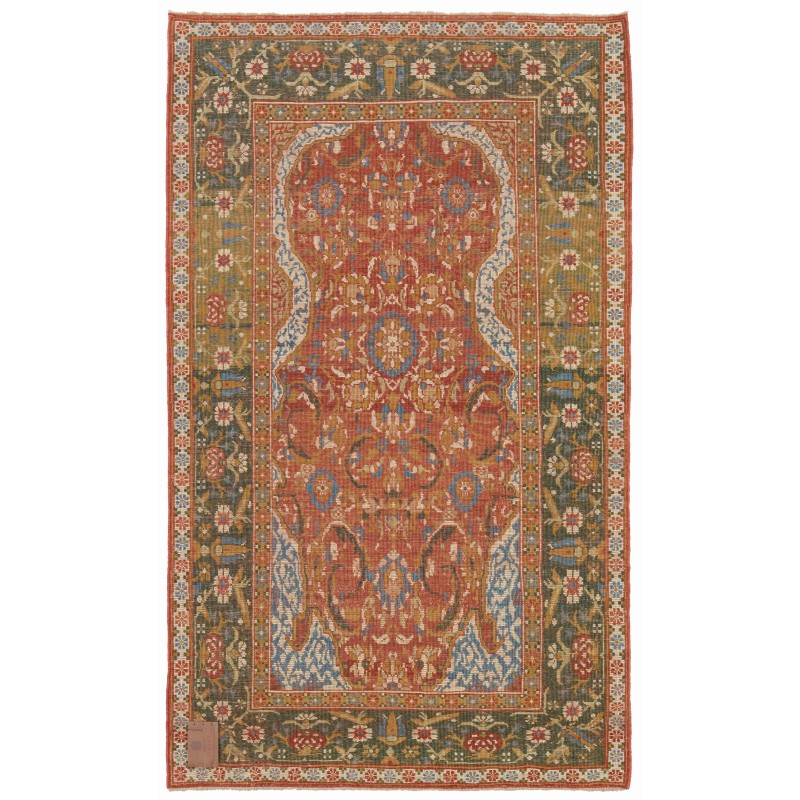



- Stock: In Stock
- Model: C50541
- サイズ: 151cm x 92cm
- Weight: 3.70kg
- SKU: ART541
16世紀にオスマン帝国によって設立されたエジプトの工房で織られたトルコ宮廷製の絨毯です。これらの絨毯はエジプトで織られ、おそらくイスタンブールで作成された紙のカートゥーンに従ってカイロに送られました。
絨毯の情報は、Dimand、Maurice S.、およびJean Maileyによる書籍「メトロポリタン美術館の東洋絨毯」から引用しました。ニューヨーク:メトロポリタン美術館、1973年、番号108、pp. 204、233、図版191。オスマンリトルコ人によるカイロ征服直後(1517年)には、エジプトで様式の変化がありました。これはイスタンブールで宮廷のために働く工場が設立されたことによるもので、絨毯産業に強力な表現を見出しました。カイロのオスマン朝絨毯は、以前の時期の絨毯と同様に、素材とカラーレンジの両方で一致しており、パレットは黄色、白色、および他の数色の使用が増えることで拡張されました。ただし、彼らは時折、カイロの基本的な3色に満足する傾向がありました。それにもかかわらず、彼らの製造の連続性に疑念が表明された場合、それらは今まで観察されていた装飾的な方向性を完全に放棄した新しい絨毯に基づいていました。植物は時に自然主義的で、特異な方法でスタイリズされ、無限に続くフィールドを完全に埋め尽くし、しばしば四隅で繰り返される大きなまたは小さなメダリオンによって中断されます。カーネーション、チューリップ、ヒヤシンス、ユリ、ボタン、および他の花々は、優雅に広がるランセットの葉、豪華なヤシの葉、繊細な花束とともに、これらの絨毯の豊かな植物群を構成しています。ボーダーは、エレガントな四隅問題の解決策で目を楽しませます。同時に、ガードストライプではほぼ例外なく、小さなバラの花が一列に現れます。マムルークの伝統からの借用がまだ見られることは稀であり、一方で、装飾の革命は既に私たちがまだ前のグループに属すると数えるいくつかの見本で予告されています。純粋な民族芸術では、このような根本的な変革は考えられませんが、工場の運営では、完全に新しいプログラムの導入は最小限の混乱で実現できます。この方向性の変化に伴い、異なる概念を持つメダリオンのアイデアがすでに活用されていたことは重要でした。この絨毯のデザインは解釈され、ソフトカラーがこの絨毯に選ばれています。
Turkish Court Manufactury Rugs were woven in the Egyptian workshops founded by Ottoman Empire in the 16th century. Those carpets were woven in Egypt, following the paper cartoons probably created in Istanbul and sent to Cairo at that time.
The source of carpet comes from the book by Dimand, Maurice S., and Jean Mailey. Oriental Rugs in the Metropolitan Museum of Art. New York: The Metropolitan Museum of Art, 1973. no. 108, pp. 204, 233, ill. fig. 191. Shortly after its conquest by the Osmanli Turks (1517), a change of style was set in Egypt which, due to the establishment of a manufactory working for the court in Istanbul, found a powerful expression in the carpet industry. The Cairene Ottoman carpets correspond with those of the previous period both in material and in color range, and the palette is extended only through the more plentiful use of yellow, white, and a few other tints; occasionally, however, they were inclined to be satisfied with the three Cairene basic colors. Nevertheless, if there have been doubts expressed regarding the continuity of their production, these were based entirely upon the fact that the new rugs completely renounced the decorative orientation which had been observed up to that point. Vegetation which at times is naturalistic, stylized in a peculiar manner, is deployed luxuriantly and, in forms that are known to us from Turkish wall tiles and brocades, quite fills the field in endless continuation, interrupted by a large or a small medallion, quadrants of which are often repeated in the corners. Carnations, tulips, hyacinths, lilies, peonies, and other flowers, together with gracefully sweeping lancet leaves, sumptuous palmettes, and delicate sprays of blossoms, constitute the rich flora of these carpets, whose borders charm the eye with their elegant solutions for the corner problem. At the same time, in the guard stripes almost invariably little rosette flowers appear all in a row. It is merely by way of exception that we will still find appropriations levied upon the Mamluk tradition, while, on the other hand, the coming revolution in decor is already heralded in a few specimens which we still count as belonging to the earlier group. In pure folk art, such a radical overturn would be quite inconceivable, but then in the operation of a manufactory, the introduction of a completely novel program can be accomplished with a minimum of confusion. With this change of orientation, it was significant that the idea of a governing medallion, even if with a different conception, had already been put to use. The design of this carpet is interpreted and soft colors are chosen by our designers for this carpet.
私たちが作ったオリジナルの絨毯です。昔の作り方、染め方全て守って明日のアンティーク絨毯を眼材しています。 この絨毯作るのに全部で 7 色使っています。
- Falu Red 400 (茜 - ヘナ - クルミの殻)
- Russian Green 418 (ヘナ - 藍)
- Natural Wool Color 320 (羊そのままの色)
- Sunray Color 405 (ヘナ)
- Dusty Turquoise 340 (トウダイグサ - 茜 - 藍 - クルミの殻)
- Pale Green 439 (カモミール - 藍)
- Burlywood 135 (トウダイグサ - 茜)
上の番号は私たちのカラーコードです。()の中は、主な草木染めの材料です。
